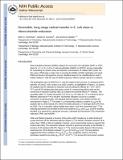Reversible, Long-Range Radical Transfer in E. coli Class Ia Ribonucleotide Reductase
Author(s)
Minnihan, Ellen Catherine; Stubbe, JoAnne; Nocera, Daniel G.
DownloadStubbe_Reversible, long-range.pdf (2.633Mb)
PUBLISHER_POLICY
Publisher Policy
Article is made available in accordance with the publisher's policy and may be subject to US copyright law. Please refer to the publisher's site for terms of use.
Terms of use
Metadata
Show full item recordAbstract
Ribonucleotide reductases (RNRs) catalyze the conversion of nucleotides (NDPs or NTPs where N = C, U, G, or A) to 2′-deoxynucleotides (dNDPs or dNTPs)[superscript 1] and are responsible for controlling the relative ratios and absolute concentrations of cellular dNTP pools. For this reason, RNRs play a major role in ensuring the fidelity of DNA replication and repair. RNRs are found in all organisms and are classified based on the metallocofactor used to initiate catalysis,[superscript 1] with the class Ia RNRs requiring a diferric-tyrosyl radical (Y•) cofactor.
Date issued
2013-06Department
Massachusetts Institute of Technology. Department of Biology; Massachusetts Institute of Technology. Department of ChemistryJournal
Accounts of Chemical Research
Publisher
American Chemical Society (ACS)
Citation
Minnihan, Ellen C., Daniel G. Nocera, and JoAnne Stubbe. “Reversible, Long-Range Radical Transfer in E. Coli Class Ia Ribonucleotide Reductase.” Acc. Chem. Res. 46, no. 11 (November 19, 2013): 2524–2535.
Version: Author's final manuscript
ISSN
0001-4842
1520-4898